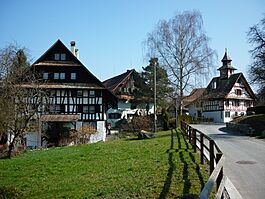Aesch, Zürich facts for kids
Quick facts for kids
Aesch
|
||
|---|---|---|
 |
||
|
||
| Country | Switzerland | |
| Canton | Zurich | |
| District | Dietikon | |
| Area | ||
| • Total | 5.24 km2 (2.02 sq mi) | |
| Elevation | 540 m (1,770 ft) | |
| Population
(Dec 2020 )
|
||
| • Total | 1,709 | |
| • Density | 326.1/km2 (844.7/sq mi) | |
| Postal code |
8904
|
|
| Surrounded by | Arni (AG), Birmensdorf, Bonstetten, Islisberg (AG), Oberwil-Lieli (AG), Wettswil am Albis | |
Aesch is a small town, also called a municipality, located in the Dietikon area of the canton of Zürich in Switzerland. Before 2001, it was known as Aesch bei Birmensdorf.
Contents
History of Aesch
Early Times
People have found signs that Roman settlers lived east of where the village is today. The community of Aesch was first written about in the year 1124. At that time, a religious group called Engelberg Abbey owned land in Aesch.
Becoming Part of Zürich
Later, when the area of Aargau was taken over, Aesch became part of Zürich. It stayed under Zürich's rule until the Helvetic Republic was formed. This was a short-lived republic in Switzerland from 1798 to 1803. During this time, Aesch was part of the Mettmenstetten district.
Changes Over Time
Until World War II, Aesch was mostly a farming community. This means most people worked on farms. From 1942 to 1946, there was a special camp in Aesch. People who were interned (kept in a camp) and emigrants (people who left their home country) lived there. They helped clear forests in the Reuetal and Stierenwald areas. In 1963, new housing areas called Brunn- und Grossacher started to be built. This helped Aesch become a more modern and central community.
First Mentions
Aesch was first mentioned in records in 1184 as Asche. After the 15th century, it was often called Esch ennend Albis.
Geography of Aesch
Aesch covers an area of about 5.2 square kilometers (or 2 square miles).
- A large part of this area, 57.7%, is used for farming.
- About 33.3% of the land is covered by forests.
- The remaining 9% of the land is where buildings and roads are located.
People and Life in Aesch (Demographics)
Population and Languages
Aesch has a population of 1,709 people (as of 31 December 2020). In 2007, about 7.2% of the people living in Aesch were from other countries. Over the past 10 years, the number of people living here has grown by about 3.1%. Most people in Aesch (93.1%) speak German. English is the second most common language (2.0%), and Italian is third (1.3%).
Politics and Elections
In the 2007 election, the most popular political party was the SVP. They received 46% of the votes. Other popular parties included:
- The FDP (15.7%)
- The SPS (11.8%)
- The CVP (9.4%)
Age and Education
Looking at the age of people in Aesch (as of 2000):
- Children and teenagers (0–19 years old) make up 20.9% of the population.
- Adults (20–64 years old) make up 67.8%.
- Seniors (over 64 years old) make up 11.3%.
About 88.2% of adults in Aesch (aged 25-64) have finished high school or gone on to higher education. This includes university or a Fachhochschule (a type of professional university).
Work and Jobs
Aesch has a low unemployment rate of 1.47%. This means most people who want to work have jobs. As of 2005:
- 58 people worked in the primary economic sector. This includes jobs like farming and forestry. There were 23 businesses in this area.
- 51 people worked in the secondary sector. This includes jobs in manufacturing and construction. There were 5 businesses in this area.
- 229 people worked in the tertiary sector. This includes jobs in services, like shops, offices, and healthcare. There were 42 businesses in this area.
In 2007, 34% of working people had full-time jobs, and 66% worked part-time.
Religion
As of 2008, there were 259 Catholics and 522 Protestants in Aesch. The 2000 census showed that:
- 57.4% of people were Protestant. Most of them (56%) belonged to the Swiss Reformed Church.
- 27.2% of the people were Catholic.
- A small number of people belonged to other religions (1.6%) or did not state a religion (0.6%).
- 13.2% of the people said they were atheist or agnostic, meaning they do not believe in a god or are unsure.
Population Over Time
Here's how the population of Aesch has changed over the years:
| year | population |
|---|---|
| 1467 | 7 Households |
| 1634 | 234 |
| 1850 | 442 |
| 1900 | 288 |
| 1970 | 472 |
| 2000 | 950 |
See also
 In Spanish: Aesch (Zúrich) para niños
In Spanish: Aesch (Zúrich) para niños








